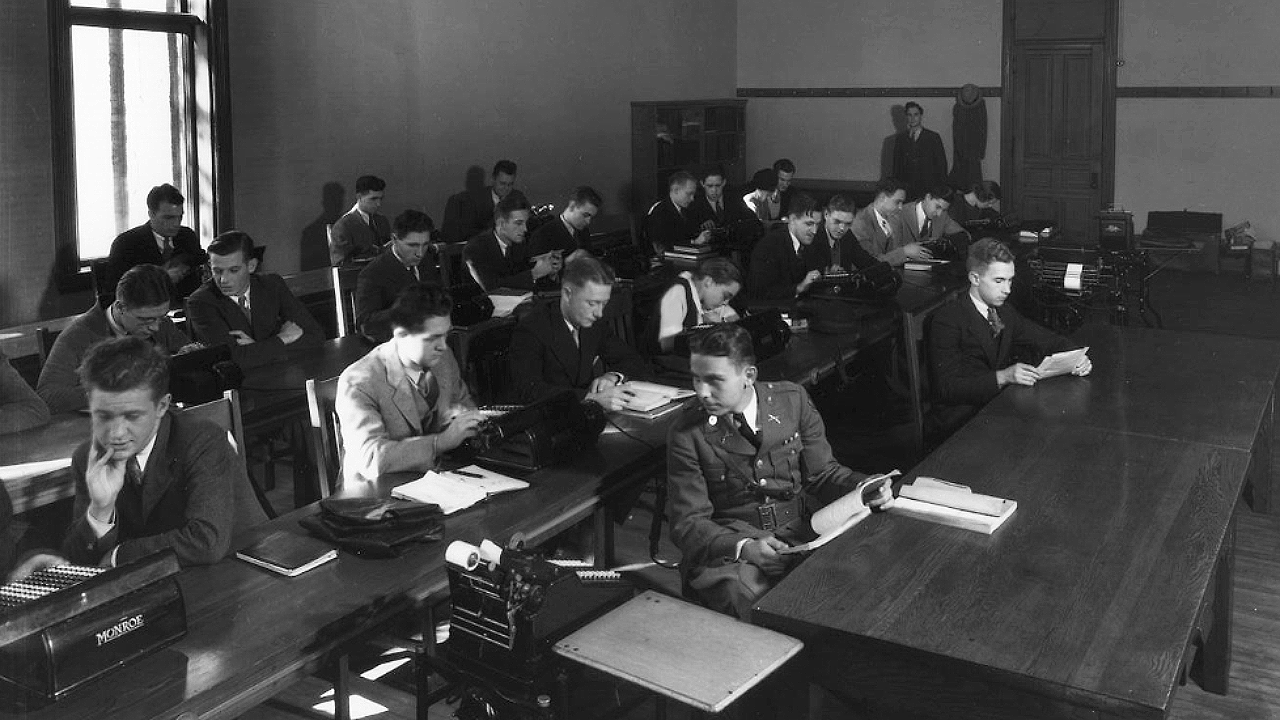
School of Business Administration students attend a class in Eddy Hall in the 1920s. Photo: Carlson School
University of Minnesota research has been in business for a long time.
This year, the University’s Curtis L. Carlson School of Management celebrated 100 years of leading business research and educating tomorrow’s corporate leaders. Few professional business schools existed in the US back when the University’s first formed. A century later, the Carlson School is Minnesota’s premier business school and highly regarded across the nation and the world.
Throughout the school’s history, its research has played an important role in developing and guiding effective, efficient, and ethical business practices. The school’s faculty include world-renowned scholars in each of the business disciplines, said Carlson School Dean Sri Zaheer, Elmer L. Andersen Chair in Global Corporate Social Responsibility, with many chosen as eminent scholars by their peers for being among the most-cited and influential in their fields.
“Their research has often shone the spotlight on the morality of workplace behavior and the unintended consequences of technological advances, pushing us to think hard about how business truly can be a force for good,” Zaheer said. “They continue to lead the conversation in critical areas such as consumer behavior and pricing, entrepreneurship, networks, AI in business, the impact of social media, and creating sustainable supply chains and effective healthcare delivery models, among others.”
Five Highlights from Carlson Research
To celebrate the school’s 100th anniversary, here are five notable moments in research from the Carlson School’s history.
1) Recovering from the Great Depression
During the economic depression that followed the stock market crash of 1929, Minnesota’s then-Governor Floyd Olson called upon the U’s School of Business Administration (it wouldn’t assume the name “Carlson School of Management” until 1986) to aid in economic recovery measures.
Using a series of grants from some of the largest philanthropic organizations in the country—such as Rockefeller, Carnegie, and Spellman—faculty and staff at the school wrote dozens of papers ranging from banking to construction to the social consequences of long-term unemployment. Economic research would remain a University research strength going forward.
2) Easing Shifting Economies
During World War II, despite business school enrollment dropping among male students and many faculty leaving for military service, research continued on.
Richard Kozelka, a longtime professor, led a study of the community of Albert Lea, MN. The Albert Lea Plan, as it was called, aimed to help ease the transition of small town economies to and from wartime conditions to account for the sudden departure of large numbers of young men and the resulting change that industries underwent from this interruption to the workforce. A similar survey was done in Red Wing, MN.
3) Ushering in Human Resources
Later in World War II, it became evident that prudent allocation and utilization of workers would remain crucial to agriculture, government, and industry even after the war ended. The business school’s Industrial Relations Center was founded in 1945, headed by faculty members Dale Yoder and Herbert Heneman.
The center brought together experts from across departments to address problems related to stabilizing employment and advancing labor standards, creating along the way a number of tools and guiding texts to help professionals in the emerging field of human resources. As one example, the Triple Audit Project (1948) linked human resource policies and employee satisfaction to the economic needs and requirements of businesses.
4) Powering Up the Computers
The business school was at the forefront of teaching students how to turn the increasing power of computers into a management tool. Professor Gordon Davis pioneered efforts to integrate computers at the school for use in decision-making and the management of organizations.
In 1968, along with fellow professors Tom Hoffman and Gary Dickson, Davis created the Management Information Systems Research Center, which taught students to apply new technologies and information systems to aid business models. The center remains one of the leading management information systems departments in the country and continues to publish the leading academic journal in the field, MIS Quarterly, which debuted in 1977.
5) Why Minnesota?
Despite its cold climate and relatively high tax rates, why are the Twin Cities such a hotbed of economic growth and industry, including boasting 17 Fortune 500 companies in the region?
In his book Headquarters Economy: Managers, Mobility, and Migration, published in 2018 by Oxford University Press, Myles Shaver, PhD, professor and Pond Family Chair in the Teaching and Advancement of Free Enterprise Principles, argues that it has largely to do with the right talent pool, especially professional managers, who tend to raise families here and stay put. Said Shaver: "The Twin Cities grows its base of professional managers not because more people move here, but because they don't leave."
Explore the Carlson School timeline for more about the school’s history or learn how Carlson School research continues on today.